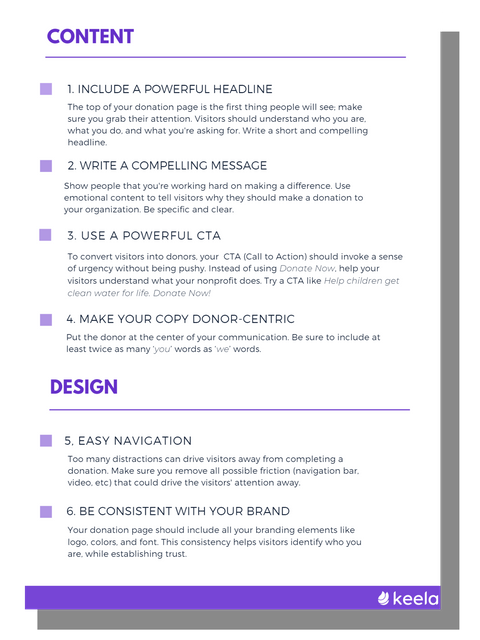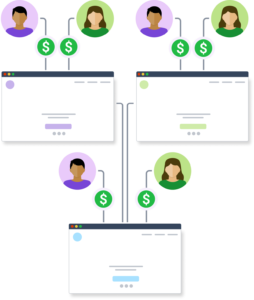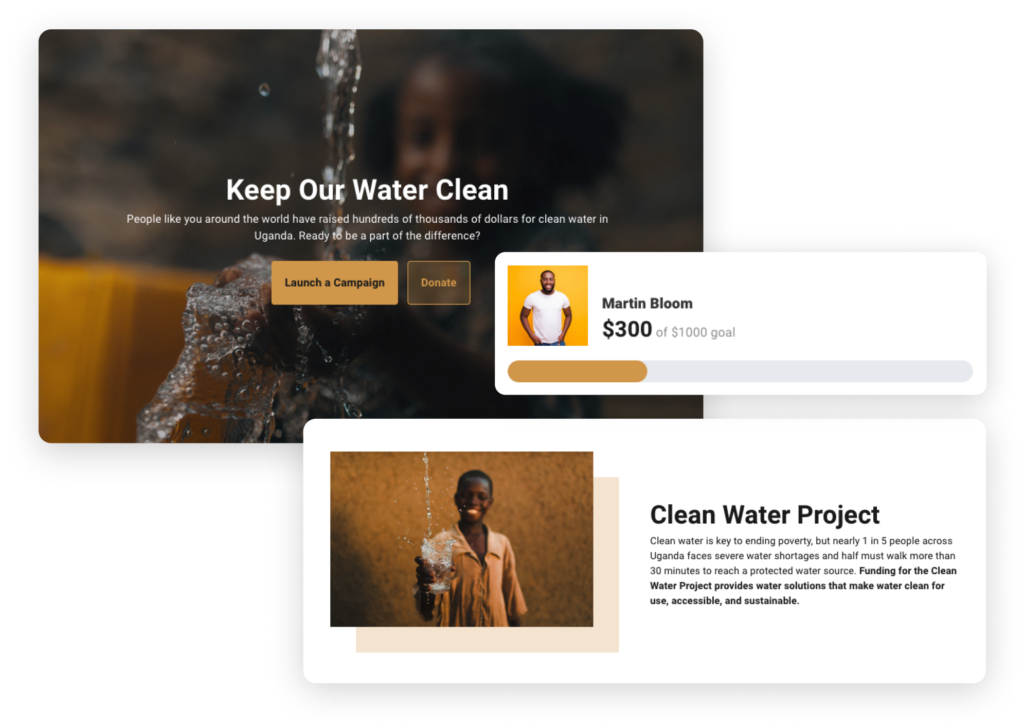Millennial Giving: How to Reach Gen Z and Millennial Donors


The Baby Boomer generation has been a cultural and economic driving force for decades, and from a fundraiser’s perspective, makes the lion’s share of nonprofit donations. But the era of Boomers is coming to a close and happily, older generations are passing the torch to their children and grandchildren.
Gen X can see the retirement light at the end of the tunnel, the Millennial population now surpasses Boomers in the US, and Gen Z is eagerly entering the workforce. Yet not all hope is lost for nonprofit organizations without the bolstered boomer dollar. Younger donors are proven to be just as generous – or even more so – than their predecessors. They’re all ready to give to causes they believe in—but what do they believe in?
You’re going to have to find out if you want to adapt to a changing donor base and embrace Gen Z, and Millennial fundraising.
What Generations Do Your Donors Belong To?
There are disagreements amongst pundits, statisticians, and sociologists as to the exact years that divide each generation, which is much a deeper debate than we can address in this post. Suffice to say that the periods presented here are roughly accurate, though they may vary by a year or two in either direction depending on who you talk to:
- Baby Boomers: Born between 1944 and 1964.
- Gen X: Born between 1965 and 1979
- Millennials: Born between 1980 and 1994.
- Gen Z: Born between 1995 and 2015.
- Generation Alpha: Born after 2015
If you’re someone who thinks of Millennials as entitled, ungrateful, selfish, phone-obsessed high-schoolers and college students, you’re actually thinking of adolescents and young adults, and even that’s pretty wrongheaded. Millennials are old enough to have mortgages and multiple kids now, and adolescents are pushing for major global societal change. So, banish your preconceptions, and let’s have a look at what some of these generations care about.
Gen X Donors
- Population: 65 million (U.S.)
- Generation X gives to causes that support animal rescue and protection, the environment and conservation, and health causes.
- Almost 30% of Gen Xers volunteer, the highest rate of any generation.
- 69% own a desktop computer, 61% own a laptop.
Millennial Donors
- Population: 72 million people (U.S.)
- Millennial generation donors support nonprofits that work on civil rights/racial discrimination, healthcare, education, and employment.
- Importantly, this generation is more concerned with issues, rather than institutions, so don’t expect donations just because your
- organization has been around for awhile.
- More than 25% of millennials use a smartphone as their main source of content.
Gen Z Donors
- Population: 90 million people (U.S.)
- The youngest named generation cares mainly about poverty, hunger, the environment, human rights, and equality.
- An incredible 98% of Gen Z owns a smartphone.
How to Reach Young Donors
Boomer fundraising used to be focused on polite phone calls that didn’t interrupt the supper hour, glossy mail outs with smiling beneficiaries, and of course, unsolicited cheques to nonprofits offering a legacy and not much else. Gen X wasn’t a lot different, except that they generally had less wealth that isn’t likely to come back.
Millennials and Gen Z don’t even answer their phones when it’s someone they know calling, never mind a fundraiser, so how are you supposed to reach them?
INTERNET, obvs . Online donations are the key to Millennial fundraising and giving. Here are five strategies to help you connect with younger donors:
See How Nonprofits Use Keela to Collect Online Donations
Get a glimpse of how Keela’s fundraising smart tools help nonprofit organizations to strategize, streamline, and automate their fundraising efforts.
1. Use Mobile-Friendly Donor Communication Tools and Channels
Since so many young donors are accessing your website and donation page via mobile devices while on-the-go, if your donation page doesn’t automatically resize to fit a smartphone, you’ve already lost the battle. The intention to give to a cause can be fleeting and if donors have to pinch zoom to read the donation instructions, what are the chances they’ll make it through the entire donation process?
Most DIY website building services, like SquareSpace and Wix, automatically scale your site to fit different screens from desktop, laptops, tablets, to smartphones. If you have a custom site, any developer worth their salt can make it mobile-responsive. And test it yourself; if it’s too hard to give to your own organization, it’s way too difficult for young professionals on a crowded subway train using their phone with one hand.
2. Simplify Your Donation Process
With several nonprofits working hard and trying to raise money, the competition to attract, engage and retain donors is intense. It’s important to make your fundraising and donation process easy for donors and supporters.
For starters, consider optimizing your donation forms. Do you really need to know your donor’s mother’s maiden name, social security number, and last three addresses? Asking for too much personal information will have donors jumping ship faster than you can say ‘Hey, but look at the impact you’ll have!”


Engage More Millennial Donors with the Perfect Donation Page
Every detail matters. Use this FREE 17-point checklist to create an engaging and high converting donation page.
3. Communicate Your Nonprofit’s Impact
Young donors generally don’t care about tradition, status, tax advantage, or anything other than actual causes. Millennials and Gen Z know that the responsibility is on everyone to try to fix the broken and problematic issues around the world, and they’re ready to give.
These generations want to feel like they’ve made an impact, like they’ve played an active role in driving positive change, and that they are contributing to something they really, really care about. So make sure you’re telling a great story. Your story is what turns casual observers to ambassadors committed to fuelling your nonprofit’s mission.
In addition to a compelling narrative, transparency and accountability mean a lot to young donors. In an age of instant and constant access to information, donors can easily figure out which nonprofits are spending 90% of donations on operational overhead. So be up front and tell donors exactly where their money is going and the impact it makes.
Lastly, millennial fundraising goes beyond monetary contributions. Ask donors to share your message on social media or volunteer with your organization. It’s a great way to build a bond and foster trust between you and your new supporters.
4. Leverage Social Media and Peer-to-Peer Fundraising Tools
Remember when social media was as simple as deciding who went in your top eight spaces? Me neither. The social network landscape quickly went from a few simple sites with a couple dozen friends to countless niche options and literally billions of eyes to try to catch.
These days, most of those eyes belong to people younger than 40. Eighty-one percent of Millennials use Facebook at least weekly , 40% follow companies or brands on Instagram, and nearly half follow companies or brands on Twitter. So if you want to reach them, you better be one of those brands.
First, make social media part of your nonprofit marketing plan so that you have the budget, staff, and time to get it done right. And don’t give the job to just any young person in your office—young or, ahem, mature, the right person for the job has unflappable positivity and a willingness to bend over backwards for your online community. To get started, read brand expert Lidia Varesco’s A-Z Guide on Social Media Marketing.
Second, consider using a peer-to-peer fundraising strategy to reach even more younger people through your existing donors’ social networks. Particularly, Facebook is transforming the way nonprofit go about P2P fundraising by making it easier for nonprofits pages to raise funds and their followers, of those pages, to share their message.
P2P is great because it encourages sharing via social media, across platforms, and it delivers your cause to the screens of people who may not have heard of your nonprofit. And even if Boomers aren’t paying attention to what you’re doing on social, they’re reading what their kids post, so you might reach some deep-pocketed retirees as a bonus.
With Keela’s Peer-to-Peer fundraising tool, you can reach and engage a wider network of donors and supporters. This tool allows your supporters to fundraise on behalf of your nonprofit. Using Keela’s highly customizable peer-to-peer fundraising pages and optimized donation forms, your supporters can spread the word about your campaign, raise money and track their progress. Such a collective effort goes a long way to helping your organization meet its fundraising goals.


Reach More Supporters with Keela’s Peer-to-Peer Fundraising Tool
Your supporters can now fundraise with you! Using Keela’s NEW peer-to-peer fundraising tool, supporters can create and share customizable fundraising pages to raise money for your nonprofit’s campaigns.
5. Nurture Your Donor Relationships
Donor Stewardship has never been more important than it is now. Young donors will likely contribute to nonprofit organizations they trust, and to build trust, you need to cultivate better donor relationships. So, take the time to study younger generations and incorporate messaging, activities, and fundraising events that resonate with them. When they make a donation, be quick to thank them. Gratitude endears donors to your brand and cause, encourages them to give again in the future, and makes them feel like their contribution was indeed worthwhile.
Thanking donors is vital, especially for younger donors. Similarly, it is important to send email communications that don’t always ask for more charitable donations. Millennials and Gen Z donors often want to be a bigger part of your organization. So while their contributions may not be as large as older major gift donors, they’re the ones who open your newsletter and are likely sharing your message.
Online Fundraising Ideas to Engage Gen Z and Millennial Donors
1. Run a Hashtag Campaign on Tiktok
There are all kinds of fun, engaging, effective online fundraising ideas you can try, but here are two that are specifically tailored to Gen Z and Millennial donors. Particularly, TikTok, is becoming a powerful fundraising tool. With a focus on user-generated video content, TikTok’s unique ability to create personal bonds over the internet can be harnessed to motivate users, particularly Gen Z, to act on causes they believe in.
Try starting a Hashtag Challenge, where users make their own videos using a common hashtag, bringing awareness, and hopefully donations, to your cause. TikTok itself is encouraging this kind of philanthropy through its TikTok For Good program , as well as offering donations for videos that support Movember and Red Nose Day. Even Bernie Sanders was raising funds using TikTok right up until he suspended his campaign and broke a lot of millennial hearts.
Best practices for TikTok are changing all the time because it’s so new, but here are a few to get you on the right track:
- Shoot vertical video: It’s counterintuitive for people who grew up with TVs and movie theaters, but make sure you prioritize vertical content because that’s how people hold their phones.
- Make it quick: As with almost all things online, shorter is better. Citizen Kane is great but no one is watching it on their phone at the bus stop.
- Don’t sell too hard: Try to make your content fun, as opposed to a straight-up ask. People want to be entertained, so dance monkey!
- Action, action, action: Don’t forget to put a call to action at the end. Otherwise, how are they going to support you?
- Watch and learn: Above all else, before you get started, download the app and watch a lot of TikTok content so you at least have a foundational understanding of what’s happening.
2. Incorporate Text Messaging into Fundraising Campaigns
Most millennials spend more than 4 hours a day on their phones. Text messaging is a major means of communication for young donors and a way great to reach and encourage them to take immediate action. To reach more younger donors, consider using text-to-give services to run your fundraising campaign.
Text-to-give (or text-to-donate) fundraising tools allow donors to give right from their text messaging app. It’s a great way to simplify the donation process and get more younger donors involved with your organization.
3. Leverage Live Game Streaming Services
Millennials and Gen Z love video games; believe it or not, the average gamer is 34 years old. And since the eSports industry was worth $138 billion in 2018, you should probably stop complaining about kids wasting their time playing Mario Kart.
One of the reasons video games are such a phenomenon is because services like Twitch have made them streamable. Now, instead of toiling away slashing down moblins in a dark basement with Cool Ranch dust all over your pants, you can play games while reaching an audience of millions. And many of those millions are completely willing to get out their credit cards and Bitcoin wallets to support their favorite Twitch personalities. And that’s where the fundraising happens.
There are three ways to monetize Twitch for fundraising purposes:
- Partner with a Streamer: Build a relationship with a popular streamer and make them your spokesperson, especially if you can find someone whose beliefs align with your nonprofit’s cause. A mention and a link to your donation page has the potential to bring in donations from around the world.
- Organize a Competition: Set up a tournament and ask the audience to donate as a way to show support for their favourite players. It’s a new take on some old fundraising events. More on this here .
- Build an Audience: Perhaps the most daunting way to do it is to become a gamer yourself, build an audience, and be your nonprofit’s spokesperson. Or, if someone at your organization is already a gamer, get them to do it. Either way, follow a setup guide to get going.
When you’re pursuing younger donors, don’t forget that culture changes very quickly, especially on the internet. What worked one year may need tweaking the next. Keep an eye out for new trends and especially new platforms—it can’t hurt to be the first nonprofit on the next big social network.




